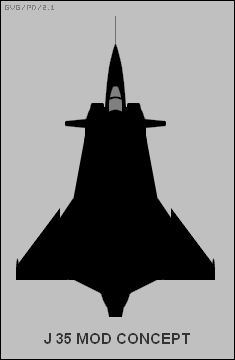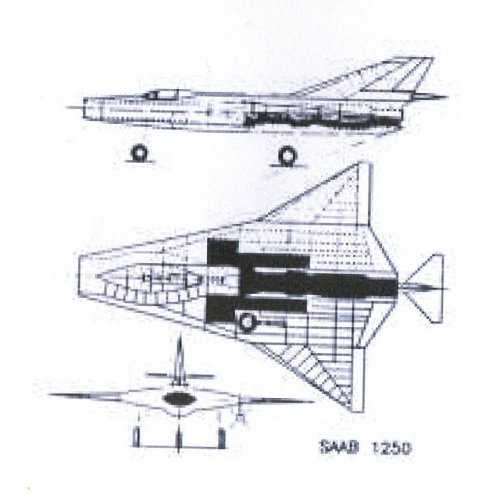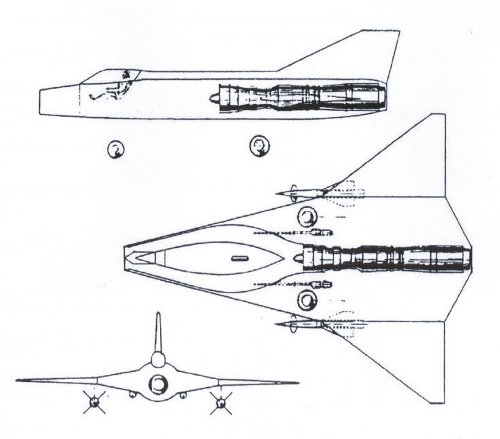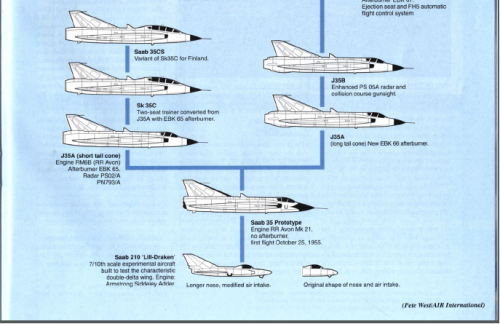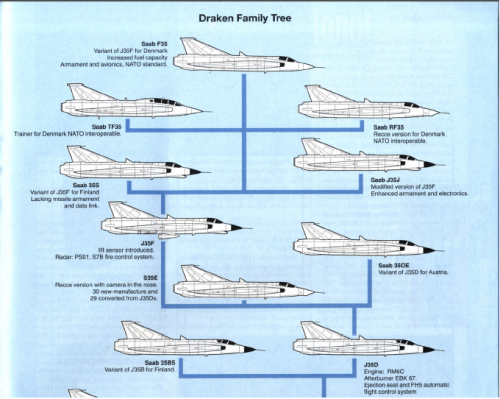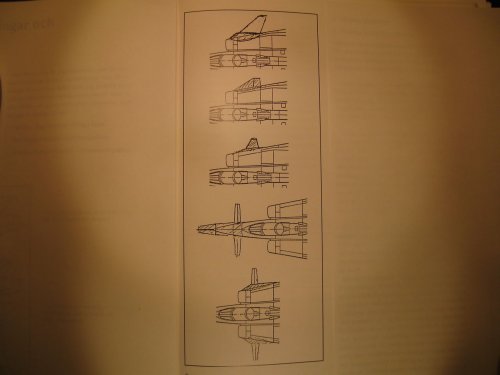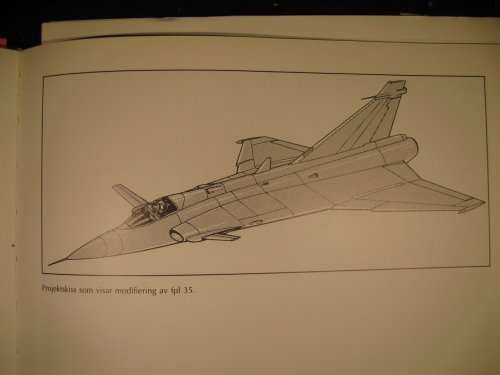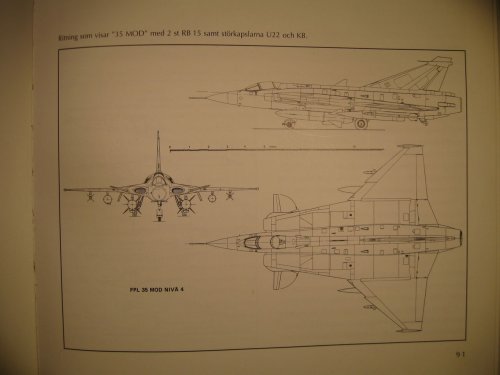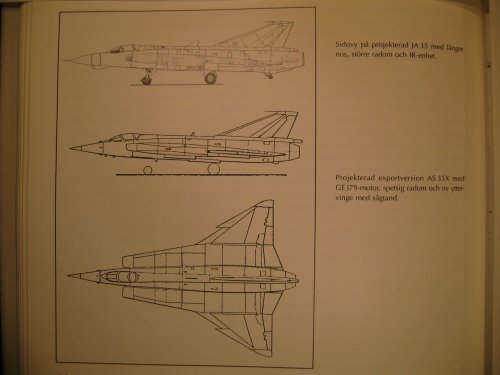You are using an out of date browser. It may not display this or other websites correctly.
You should upgrade or use an alternative browser.
You should upgrade or use an alternative browser.
SAAB J 35 Draken
- Thread starter rousseau
- Start date
- Joined
- 8 January 2006
- Messages
- 1,612
- Reaction score
- 763
I don't remember seeing it online, but I can make a few educated guesses about it. The aiircraft is clearly an early model, I'm not even certain it has the tail bumper wheels, though it does have the extended aft end that was retrofitted to the prototypes. My opinion is that it's a J-35A used for trials purposes. If memory serves me correctly, the ancient Lindberg 1/48 Draken kit reflects this armament configuration.
Hi guys! 
I have seen this image before in books, but not on the web,,, I think.
The Draken in that pic is a J35D. You can tell by the extended intakes that stretch almost as far as the windscreen. The plane has a model 66 afterburner, which is portrayed by the long tail (some J35A and all J35B had the longer tail, but not the extended intakes).The barely visible aerodynamic bump at the lower far end of the fuselage houses the tail wheel.
This very Draken belongs to the F13 wing at Bråvalla, Norrköping and it is a standard operative J35D. The F13 wing usually conducted tactical tests of RSwAF fighters. The plane in the image is probably 35304 or 35310.

http://www.volvo.com/NR/rdonlyres/4984B158-5BA7-4C7F-9C04-9C5FCA10BD5B/0/history_aero_J35_draken_highres.jpg
Here's a chart that shows some of the most immediate differences between the prototype J35, the J35A, B and D.
http://www.ipms.nl/sigs/sweden/dradra2.jpg
I have seen this image before in books, but not on the web,,, I think.
The Draken in that pic is a J35D. You can tell by the extended intakes that stretch almost as far as the windscreen. The plane has a model 66 afterburner, which is portrayed by the long tail (some J35A and all J35B had the longer tail, but not the extended intakes).The barely visible aerodynamic bump at the lower far end of the fuselage houses the tail wheel.
This very Draken belongs to the F13 wing at Bråvalla, Norrköping and it is a standard operative J35D. The F13 wing usually conducted tactical tests of RSwAF fighters. The plane in the image is probably 35304 or 35310.
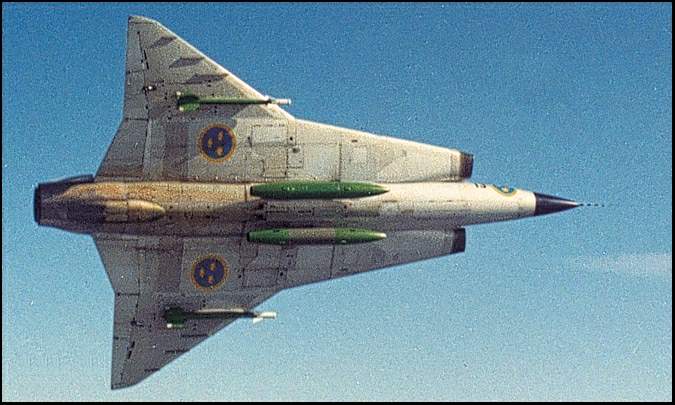
http://www.volvo.com/NR/rdonlyres/4984B158-5BA7-4C7F-9C04-9C5FCA10BD5B/0/history_aero_J35_draken_highres.jpg
Here's a chart that shows some of the most immediate differences between the prototype J35, the J35A, B and D.
http://www.ipms.nl/sigs/sweden/dradra2.jpg
Hi all,
Lets talk about this nice looking J35?
I found this pic on the net and would like to know more but there is not much out there can anyone help?
Any info or 3 view drawings would be great!
The drawing is from this web site........http://www.vectorsite.net/avj35.html
Thanks,
Lockon
Lets talk about this nice looking J35?
I found this pic on the net and would like to know more but there is not much out there can anyone help?
Any info or 3 view drawings would be great!
The drawing is from this web site........http://www.vectorsite.net/avj35.html
Thanks,
Lockon
Attachments
I found some info here:
http://www.canit.se/~griffon/aviation/text/35draken.htm
"The most extensive AJ 35 Draken upgrade, 35 MOD level 4, would have consisted of new outer wings giving a 1 m greater span with small dogtooths, a fin extension, additional elevon actuators and some kind of canards -- most likely flip out moustaches on the sides of the air intakes. Clearance between the RBS 15F fins under the front wings and the ground would have been 44 mm.
The load out could have consisted of 2 x RBS 15F under the front wings, 2 x tanks under the fuselage the countermeasures pods U22 and KB (as on Viggen) and outboard of them Sidewinders or RB 28 Falcons under the outer wings. It would have retained the one built in 30 mm gun and also be capable of carrying Mavericks and the 6 x 135 mm rocket pods."
http://www.canit.se/~griffon/aviation/text/35draken.htm
"The most extensive AJ 35 Draken upgrade, 35 MOD level 4, would have consisted of new outer wings giving a 1 m greater span with small dogtooths, a fin extension, additional elevon actuators and some kind of canards -- most likely flip out moustaches on the sides of the air intakes. Clearance between the RBS 15F fins under the front wings and the ground would have been 44 mm.
The load out could have consisted of 2 x RBS 15F under the front wings, 2 x tanks under the fuselage the countermeasures pods U22 and KB (as on Viggen) and outboard of them Sidewinders or RB 28 Falcons under the outer wings. It would have retained the one built in 30 mm gun and also be capable of carrying Mavericks and the 6 x 135 mm rocket pods."
Hi Jschmus,
Thanks for your info was a big help!
I will head to the website and have a read, I was hopping there would be more people out there that would know more about this aircraft or even give there ideas on it.
I still hope that a 3 view drawing will show up here some day.
Lockon.
Thanks for your info was a big help!
I will head to the website and have a read, I was hopping there would be more people out there that would know more about this aircraft or even give there ideas on it.
I still hope that a 3 view drawing will show up here some day.
Lockon.
- Joined
- 1 April 2006
- Messages
- 11,402
- Reaction score
- 10,340
J35 was aerodinamically stable aircraft with some limitations.
http://www.aircraftinformation.info/art_draken.htm
here was no horizontal tailplane, even though Saab engineers had considered fitting one. A few wind tunnel models were built with tailplanes, but during wind tunnel testing it was found that this configuration was unstable, and so the tailplane was dropped.
ftp://ftp.rta.nato.int/PubFullText/RTO/TR/RTO-TR-029/TR-029-02.pdf
SAAB’s experience of the PIO phenomenon had commenced
with the J-35 Draken aircraft. This aircraft had high stick sensitivity combined with a linear gearing of the
stick to elevon. Following the PIO, the solution devised was to add a non-linear gearing and improve the
stability augmentation of the system.
http://www.flug-revue.rotor.com/FRHeft/FRHeft05/FRH0511/FR0511e.htm
Wing Commander Doro Kowatsch, the former commander of the air surveillance wing, is today the commander of Flight Regiment 2. He still has a soft spot for the Draken. “That aircraft cut through the air like a hot knife through soft butter,” is how the former Draken display pilot describes the aerodynamic properties of the double-delta wing fighter. “The Draken is very responsive to all control inputs and its narrow tolerances allow little leeway, which means that pilots end up being very disciplined in the way that they fly. The low-speed characteristics take some getting used to, especially in a delta-wing aircraft, as does the high angle of attack on landing. On the other hand the Draken withstands turbulence very well. But a stall warning has to be taken extremely seriously, as the aircraft becomes aerodynamically unstable even before the stall – you have to stick to the ground rules precisely.”
http://www.aircraftinformation.info/art_draken.htm
here was no horizontal tailplane, even though Saab engineers had considered fitting one. A few wind tunnel models were built with tailplanes, but during wind tunnel testing it was found that this configuration was unstable, and so the tailplane was dropped.
ftp://ftp.rta.nato.int/PubFullText/RTO/TR/RTO-TR-029/TR-029-02.pdf
SAAB’s experience of the PIO phenomenon had commenced
with the J-35 Draken aircraft. This aircraft had high stick sensitivity combined with a linear gearing of the
stick to elevon. Following the PIO, the solution devised was to add a non-linear gearing and improve the
stability augmentation of the system.
http://www.flug-revue.rotor.com/FRHeft/FRHeft05/FRH0511/FR0511e.htm
Wing Commander Doro Kowatsch, the former commander of the air surveillance wing, is today the commander of Flight Regiment 2. He still has a soft spot for the Draken. “That aircraft cut through the air like a hot knife through soft butter,” is how the former Draken display pilot describes the aerodynamic properties of the double-delta wing fighter. “The Draken is very responsive to all control inputs and its narrow tolerances allow little leeway, which means that pilots end up being very disciplined in the way that they fly. The low-speed characteristics take some getting used to, especially in a delta-wing aircraft, as does the high angle of attack on landing. On the other hand the Draken withstands turbulence very well. But a stall warning has to be taken extremely seriously, as the aircraft becomes aerodynamically unstable even before the stall – you have to stick to the ground rules precisely.”
- Joined
- 4 May 2008
- Messages
- 2,439
- Reaction score
- 762
The October 2005 issue of Flight Journal has a nice article on J-35 and J-37 aerodynamics by Barnaby Wainfan (of Northrop advanced concepts). I highly recommend it. Among other things it gives a very clear account of how both airplanes ended up with the planform they have.
"here was no horizontal tailplane, even though Saab engineers had considered fitting one. A few wind tunnel models were built with tailplanes, but during wind tunnel testing it was found that this configuration was unstable, and so the tailplane was dropped."
Please see attached two drawings of the SAAB P.1250
Please see attached two drawings of the SAAB P.1250
Attachments
This quote didn't tell us what does exactly unstable mean here?here was no horizontal tailplane, even though Saab engineers had considered fitting one. A few wind tunnel models were built with tailplanes, but during wind tunnel testing it was found that this configuration was unstable, and so the tailplane was dropped.
What I mean unstable is GoC behind LoC which like F-16, but no matter tailplane was added or not, the meaning of unstable here sounds like a flying situation? ???
- Joined
- 13 June 2007
- Messages
- 2,173
- Reaction score
- 3,096
Pretty impressive considering the age of the aircraft and none of the bells and whistles of today's aircraft:
http://www.youtube.com/watch?v=jqiDEcfSnXs&feature=related
Enjoy the Day! Mark
http://www.youtube.com/watch?v=jqiDEcfSnXs&feature=related
Enjoy the Day! Mark
Hi, I'm looking for info on the proposed JA 35 MOD upgrades to the J 35 Draken.
Here's what I got so far:
http://www.aircraftinformation.info/art_draken.htm#proposed
http://www.x-plane.org/home/urf/aviation/text/35draken.htm#projected
Here's what I got so far:
http://www.aircraftinformation.info/art_draken.htm#proposed
http://www.x-plane.org/home/urf/aviation/text/35draken.htm#projected
FPL 35 MOD NIVA 4 was a proposal to modify the J-35 Draken to make it a RBS-15 shooter. The proposal was made before the 1982 decision to go ahead with the JAS-39 Gripen.
The drawing was shown in the transcript of a lecture given at the Royal Aeronautical Society in 1983, and "FPL JAS 2 105" single seat fighter project was also mentioned in the transcript.
The drawing was shown in the transcript of a lecture given at the Royal Aeronautical Society in 1983, and "FPL JAS 2 105" single seat fighter project was also mentioned in the transcript.
Attachments
Saab promotional film for the J35 Draken produced in the 1950s.
http://www.youtube.com/watch?v=LhCSSlfNJk8&feature=share&list=TLhQa3GQRpVb8
http://www.youtube.com/watch?v=LhCSSlfNJk8&feature=share&list=TLhQa3GQRpVb8
perttime
I really did change my personal text
- Joined
- 30 March 2013
- Messages
- 311
- Reaction score
- 318
Saab Draken Display flight in Sweden, 2012: Försvarsmaktens Veteranflygverksamhet, or Defence Force Historical Flight (my very free translation)
http://www.youtube.com/watch?v=4b_JkQ21u7s
The Finnish "Draken In Memoriam" video
http://youtu.be/qWOINzyCLL4
http://www.youtube.com/watch?v=4b_JkQ21u7s
The Finnish "Draken In Memoriam" video
http://youtu.be/qWOINzyCLL4
Clipper996
Indeed
- Joined
- 16 April 2013
- Messages
- 20
- Reaction score
- 2
Does anyone know what are the flight control deflection rates for the Saab Draken?
- Joined
- 26 May 2006
- Messages
- 34,928
- Reaction score
- 15,798
tiikki
Why I really should change my personal text?
hesham said:Sorry Clipper996,
I am not qualified to answer this question,but we can send here some SAAB-35
Draken variants.
Air International 3/2000
Your source had it wrong about Finnish Drakens.
http://tiikki.blogspot.fi/2013/03/saab-draken-in-finnish-air-force-and.html
Here is some information which I've collected.
tiikki
Why I really should change my personal text?
Hi,
Text in your graph claimed that Finnish Draken fighters didn't have missile armament. They had missiles. The BS model in Finland was lacking radar, but had RB24 Sidewinder capability, only CS was missing Air to air missiles.
There were two F versions in Sweden, F1 and F2, with F2 being the later one with IR sensor. The Finnish 35(X)S was F2 model without STRIL-datalink, while 35FS were used Swedish F1 aircraft. All Finnish aircraft received J upgrade later on, but their designation didn't change, they also received Finnish datalink capability.
Tuomo
Text in your graph claimed that Finnish Draken fighters didn't have missile armament. They had missiles. The BS model in Finland was lacking radar, but had RB24 Sidewinder capability, only CS was missing Air to air missiles.
There were two F versions in Sweden, F1 and F2, with F2 being the later one with IR sensor. The Finnish 35(X)S was F2 model without STRIL-datalink, while 35FS were used Swedish F1 aircraft. All Finnish aircraft received J upgrade later on, but their designation didn't change, they also received Finnish datalink capability.
Tuomo
Not sure of the book (yet) though I found the images on the IPMS Uppsala website.
- Joined
- 27 March 2006
- Messages
- 1,876
- Reaction score
- 1,622
I can't think of any real benefits for a J-79 version compared to the RM6, to be frank. ???
Maybe export orientated, but then Sweden was notoriously fickle about who they would sell jet fighters to.
Maybe export orientated, but then Sweden was notoriously fickle about who they would sell jet fighters to.
- Joined
- 17 October 2006
- Messages
- 2,393
- Reaction score
- 1,198
It also has a smaller-volume, more pointed nose and an added wing sawtooth. And in Swedish designation schemes, AS would mean "attack/recce".
More here: http://www.aircraftinformation.info/art_draken.htm#proposed
More here: http://www.aircraftinformation.info/art_draken.htm#proposed
- Joined
- 18 March 2008
- Messages
- 3,529
- Reaction score
- 990
kaiserbill said:I can't think of any real benefits for a J-79 version compared to the RM6, to be frank. ???
The J79 offered a 10% saving in fuel burn at military power. Which equals more range. Plus it was more robust as a fighter engine, able to handle more abrupt throttle movements, thanks to its variable stators. Also the J79 was much cooler on the outside than the Avon 300. This could be quite significant with a Draken style design with the engine buried in the centre of the fuselage. In that it would require less heat management by the airframe, controls, avionics, etc. therefore reducing overall weight, maintenance needs and improving reliability.
kaiserbill said:Maybe export orientated, but then Sweden was notoriously fickle about who they would sell jet fighters to.
This well-known phenomenon only developed at a later date. Before the succession of Olof “US Bombing of Hanoi in 1972 is another Katyn or Sharpeville Massacre” Palme to the Prime Ministerial office (in 1969) his mentor Tage Erlander was far less romantic in foreign affairs. Sweden extensively tried to sell their domestic weapons abroad in the 50s and 60s. They were even quite upset when they failed to sell the Lansen strike fighter to South Africa.
- Joined
- 27 March 2006
- Messages
- 1,876
- Reaction score
- 1,622
Thanks Abe.
I guess I was simply looking at the physical dimensions of the J-79 vs the RM6 as well as thrust. The J-79 is about 2 meters longer than the RM6, about 10% wider, and almost half a ton heavier, for roughly the same thrust. I think it has a higher airflow requirement too.
I would guess that would require a massive redesign to the aft-of-cockpit fuselage internal structure, as well as centre of gravity considerations...etc
Hence my pondering wonderment at benefits.
Thanks for the info on the Swedish defence export issue. Whilst being aware of Palme's odd foreign policies, I wasn't aware of his mentors/predecessors relative real politik.
Not to derail, but a quick question: Do you know what requirement the Lansen was aimed at to compete in South Africa? Was it a strike or intercept role? Trying to figure whether it was aimed at competing against the Mirage III/Sabre/Buccaneer/Canberra, all of which were SAAF projects/purchases in the late 50's/early 60's.
And with the above mentioned info about the Lansen, and in context of this topic, was the J35 Draken ever offered in competition to the Mirage III to the SAAF?
I guess I was simply looking at the physical dimensions of the J-79 vs the RM6 as well as thrust. The J-79 is about 2 meters longer than the RM6, about 10% wider, and almost half a ton heavier, for roughly the same thrust. I think it has a higher airflow requirement too.
I would guess that would require a massive redesign to the aft-of-cockpit fuselage internal structure, as well as centre of gravity considerations...etc
Hence my pondering wonderment at benefits.
Thanks for the info on the Swedish defence export issue. Whilst being aware of Palme's odd foreign policies, I wasn't aware of his mentors/predecessors relative real politik.
Not to derail, but a quick question: Do you know what requirement the Lansen was aimed at to compete in South Africa? Was it a strike or intercept role? Trying to figure whether it was aimed at competing against the Mirage III/Sabre/Buccaneer/Canberra, all of which were SAAF projects/purchases in the late 50's/early 60's.
And with the above mentioned info about the Lansen, and in context of this topic, was the J35 Draken ever offered in competition to the Mirage III to the SAAF?
sferrin said:Have loved the Draken since I was a kid. Cool aircraft.
Me too - possibly the best-looking fighter jet ever made. One of my "what ifs" from the 1950s is a collaboration between the Swedes and the Brits to build the Draken (it used a British engine and British guns, which is a start!). It could have been a great Hunter replacement, less suited to interception than the Lightning but far more versatile - and exportable. With the RAF prestige behind it (worth a lot then), it could have taken a very large slice of the international market which actually went to the Mirage family.
- Joined
- 18 March 2008
- Messages
- 3,529
- Reaction score
- 990
kaiserbill said:Thanks Abe.
No problem.
kaiserbill said:I guess I was simply looking at the physical dimensions of the J-79 vs the RM6 as well as thrust. The J-79 is about 2 meters longer than the RM6, about 10% wider, and almost half a ton heavier, for roughly the same thrust. I think it has a higher airflow requirement too.
The comparison of tab data is not quite right. The Swedes did not consider the engine and the afterburner as a single unit. So if you are looking at tabulated data for the Volvo RM6B or RM6C it does not include the afterburners which were the Ebk 65, 66 and 67. On the other hand US tab data includes the afterburner if the engine model was so fitted.
The RM6C with Ebk 67 (as fitted to the J35D and later models) was 138” (8,140mm) long with a 44” (1,118mm) diameter and weighed in at 3,902 lbs (1,770 kg) dry (no fuel and oil in it). However much of this length (and a bit of the weight) is consumed by a pipe extension to connect the forward mounted engine and the aft mounted afterburner. This engine produced up to 12,456 lbs thrust (max military) or 17,086 lbs (max reheat).
There is no off the shelf J79 that could replace the RM6C + Ebk 67 because of the separation of the engine and afterburner. However the RM6C by itself could be replaced by a CJ805 which was the afterburnerless, civil version of the J79 as used by the fast and cool looking Convair 880 and 990 airliners. This engine could then be integrated with the Swedish afterburner to achieve the improvements I mentioned in my first post (less fuel burn, better throttle response and less cooling).
kaiserbill said:I would guess that would require a massive redesign to the aft-of-cockpit fuselage internal structure, as well as centre of gravity considerations...etc
Integrating a new engine into the Draken is always going to require some work because it is buried inside the transverse framing of the forward fuselage which is the main structure of the aircraft. It required extensive work just to go from RM6B to RM6C. However the CJ805 is inside the key dimension footprints of the RM6C. And you could convert a J79 with the insert of a pipe between the turbine and the burner that would fit inside the same volume and weight of the RM6C + Ebk 67. Any changes to intake volume could be easily accommodated with the Draken’s fixed nozzle design and the quite large additional airflows brought in for cooling the centre fuselage with the RM6C. The changes would not be massive nor would they have major influence on the CG. As long as you kept to the engine, pipe, burner design.
kaiserbill said:Hence my pondering wonderment at benefits.
The devil is always in the details.
kaiserbill said:Thanks for the info on the Swedish defence export issue. Whilst being aware of Palme's odd foreign policies, I wasn't aware of his mentors/predecessors relative real politik.
Sweden went from by-the-book, conservative, neutral but anti-communist to by-the-book, radical and “non-aligned” aligned in its foreign policies.
kaiserbill said:Not to derail, but a quick question: Do you know what requirement the Lansen was aimed at to compete in South Africa? Was it a strike or intercept role? Trying to figure whether it was aimed at competing against the Mirage III/Sabre/Buccaneer/Canberra, all of which were SAAF projects/purchases in the late 50's/early 60's.
All I know is that the Swedes were disappointed they didn’t sell the Lansen to South Africa. No further details. I can't even remember were I read it (at the moment).
Attachments
- Joined
- 18 March 2008
- Messages
- 3,529
- Reaction score
- 990
Tony Williams said:sferrin said:Have loved the Draken since I was a kid. Cool aircraft.
Me too - possibly the best-looking fighter jet ever made.
Its performance is also quite impressive. Like a Mirage III but much tougher, with far better avionics and able to land and takeoff in a WWII standard 3,000 foot runway.
- Joined
- 28 November 2006
- Messages
- 712
- Reaction score
- 738
Abraham Gubler said:This well-known phenomenon only developed at a later date. Before the succession of Olof “US Bombing of Hanoi in 1972 is another Katyn or Sharpeville Massacre” Palme to the Prime Ministerial office (in 1969) his mentor Tage Erlander was far less romantic in foreign affairs. Sweden extensively tried to sell their domestic weapons abroad in the 50s and 60s. They were even quite upset when they failed to sell the Lansen strike fighter to South Africa.
At http://www.x-plane.org/home/urf/aviation/text/exports.html you may find such information of Lansen export efforts:
Saab marketed Lansen during 1953-54 to Norway, Denmark, The Netherlands, Switzerland, Yugoslavia, Argentine, Venezuela and India.
India were somewhat interested in licence production of 25-40 Lansens at HAL. Saab delivered an offer in 1954. Interest increased in 1957 when series aircraft had flown and India then discussed a purchase of 10 photo reconnaissance and 20 fighter-bombers followed by licence production of 300 more. India purchased British aircraft instead.
South Africa also seriously discussed Lansen but never bought any (possibly because Saab didn't have export experience, possibly because the Swedish air force wanted their Lansens first and happily payed more even though they'd be cheaper with a larger production run, reasons which aren't unique for this case).
Pilots from the Finnish air force flew S 32C in 1957, but they really wanted fighters, so this was hardly a part of a genuine export drive.
- Joined
- 27 March 2006
- Messages
- 1,876
- Reaction score
- 1,622
Abe Gubler, thanks for that response. Some great detail in there.
I wasn't aware of how long the RM6 (with afterburner) for the J35 is!
Petrus, thanks for that. It's a pity that source doesn't seem to mention a year, nor what role/procurement programme the Lansen was aimed at.
I wasn't aware of how long the RM6 (with afterburner) for the J35 is!
Petrus, thanks for that. It's a pity that source doesn't seem to mention a year, nor what role/procurement programme the Lansen was aimed at.
- Joined
- 21 May 2006
- Messages
- 3,003
- Reaction score
- 2,284
Its performance is also quite impressive. Like a Mirage III but much tougher, with far better avionics and able to land and takeoff in a WWII standard 3,000 foot runway.
G’day Abraham Gubler
That’s interesting information on the Draken vs the Mirage III!
I’ve argued the point of the Draken’s inherent superiority and ruggedness over that of the Mirage III series for years…decades, with an old mate. My principle argument being that Australia/RAAF should have seriously considered the J35 Draken over the Mirage III. Adding to the fact that the Draken was all-weather capable before the Mirage III, it was designed to be refuelled and rearmed in no more than ten minutes, by conscripts with minimal training, and of course, its RM 6B/C turbojet was a derivative of the Rolls-Royce Avon 200/300, which was well versed and trusted within the RAAF!
P.S. is there any chance you point me out the source to your above comment please?
Regards
Pioneer
- Joined
- 26 January 2011
- Messages
- 2,226
- Reaction score
- 645
Australia learnt a valuable lesson about the fickleness of arms exporters (particularly Swedish ones) from it's purchase of the L35a1 Charles Gustav RCL in the early-mid-1960s. When they attempted to use them in South Vietnam, they found their only suppler of ammunition for the RCL - in Sweden - on instructions from the Swedish Government refused to supply them! The result was that the L35a1s were left behind in Australia and the Infantry Company AT Sections deployed as combat dog teams. I can only imagine what would have happened with the Draken...
That reminds me that the British government once refused to supply Israel with 105mm tank gun ammunition for their Centurion tanks, as a result of pressure from the Arab oil states.
Similar threads
-
Swedish Missiles and Missile Projects.
- Started by Tzoli
- Replies: 38
-
-
-
-


